Circuit at your own pace Madrid and surroundings
- FREE CANCELLATION FEES up to 7 days before the start
- Circuit your own way - by car
- 7 days / 6 nights in bed and breakfast basis in Madrid
- Tickets to the Reina Sofía Museum or Tickets for the Royal Palace of Madrid
- Tickets for the Royal Palace of La Granja of San Ildefonso
- Guided tour at the Royal Site of San Lorenzo of El Escorial
- Free Cancellation Insurance (up to 30 coverages)
- Total price per person in double / triple room: € 530
- To formalize the reservation, reservation deposit price: € 60 / person. Rest of payment, 15 days before the start
Circuit at your own pace by car in which in 7 days (6 nights) you will enjoy different places and accommodation in the largest city in Spain and one of the most charming autonomous communities. A few days to admire and study all the treasures of one of the capitals of Europe. From the most regal Madrid to the most current with stops in Segovia and Toledo among other neighboring cities, witnesses of the history of Spain






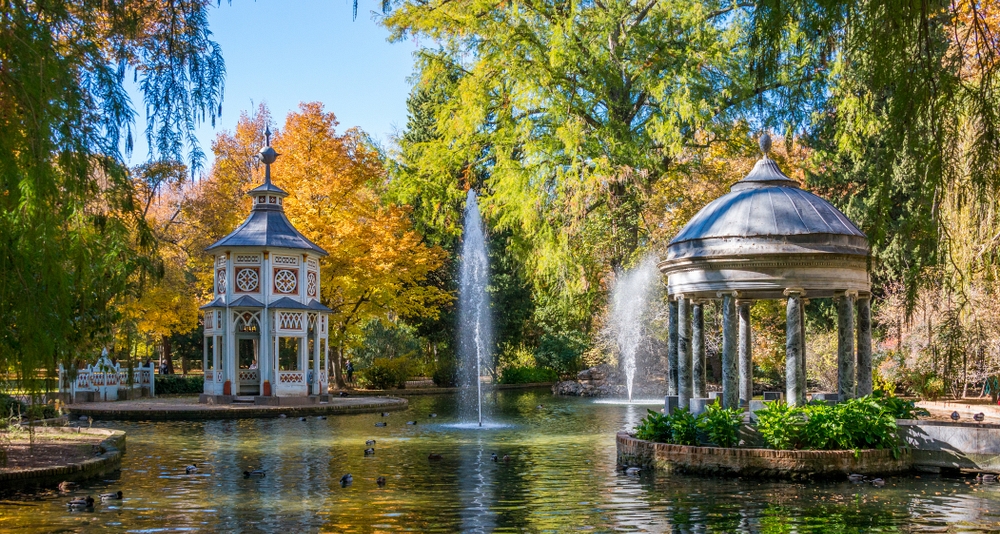









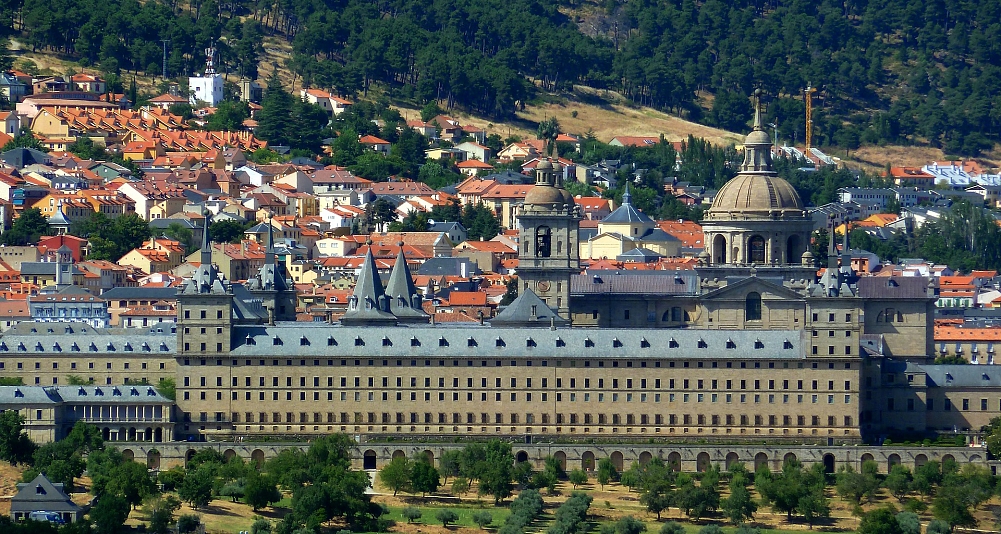




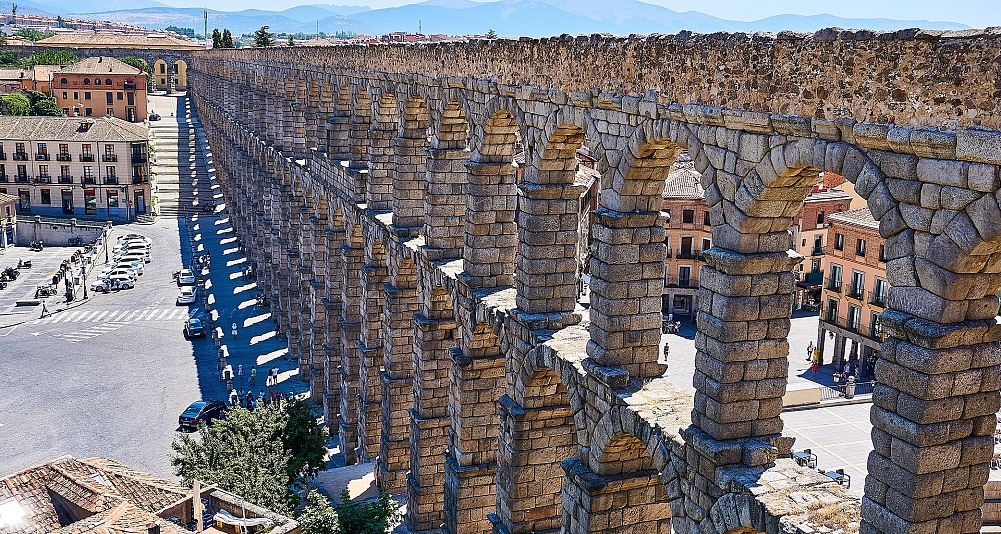
















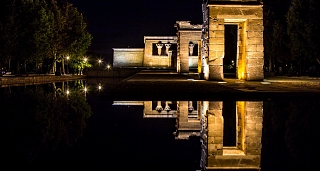


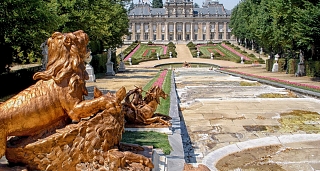
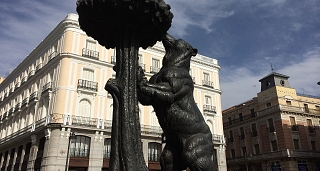



1st Day. Origin - Madrid
Upon arrival at the chosen hotel we will check-in and get ready to enjoy the local culture.
We will take this day as free time to unpack our luggage and relax with a walk and a good overview of the city and its streets. After this free afternoon we will return to the hotel to be well rested for the next day with more action.
Day 2. Madrid - Royal Palace (optional)
We will have breakfast at the hotel and at the agreed time we will go to tour the city. We are going to suggest an itinerary to fully explore the heart of Madrid in two days.
We will start at kilometer zero of the roads in Spain, the Puerta del Sol. This square is one of the most popular in the city since in it we find some of its greatest representative elements: the statue of the bear and the strawberry tree and that of Carlos III on horseback, the Post Office building or the Tío Pepe advertisement, among others.
We will continue along Calle Mayor to Plaza Mayor in Madrid. Inaugurated in 1619, it has a completely closed rectangular floor plan with arcaded residential buildings and 237 balconies. It consists of 10 entrances, the most renowned being the Arco de Cuchilleros. Two buildings also stand out, the Casa de la Carnicería and the Casa de la Panadería where even today it is possible to see the coat of arms of King Carlos II.
Leaving the Plaza we can stop at the Mercado de San Miguel and observe its original iron structure from the beginning of the s. XX.
From there we will arrive at the Basilica of San Miguel, declared a National Historic Artistic Monument in 1984, it is one of the most important Baroque buildings in Spain despite its small size. This is especially due to the unique convex shape of its façade.
We will stroll around this area a bit until we reach the Almudena Cathedral. Its construction lasted more than 100 years, it was consecrated in 1993, and it is impressive more for its grandeur and history than for its style. It is possible to visit both the cathedral and the crypt for a donation of €1 and the museum and the dome for a combined fee of €6.
Next to the cathedral we find the Royal Palace of the s. XVIII. If we so choose, within the two optional visits in Madrid, we will be able to investigate it in depth. It is one of the largest and most spectacular in all of Europe and just looking at the Gasparini Hall is worth it.
When we have finished seeing the Royal Palace, we will continue our tour to the Plaza de Oriente, just in front of the Puerta del Príncipe. Here is a statue on horseback from the s. XVII of Felipe IV and just behind the Royal Theater.
Passing in front of the Sabatini Gardens we will arrive at the Principe Pio Mountain. It has a viewpoint with impressive views of the Royal Palace, and more importantly the Temple of Debod. This small temple was donated by the Egyptian government and moved stone by stone. It is over 2,200 years old.
Right next to this Mountain is the Plaza de España, another of the best known. Here we will observe the 35-meter monument to Cervantes with the Edificio España and the Torre de Madrid in the background.
From this point we will take the Gran Vía to conclude our day strolling through this great artery of Madrid.
Day 3. Madrid - Reina Sofía Museum (optional)
Second day in our escapade through Madrid. Breakfast and ready we will continue the adventure where we left off yesterday. In this case starting with the Círculo de Bellas Artes. The 360 views of the Madrid sky from its rooftop have become a must-see on any route in Madrid.
We will pass through the Plaza Cibeles, with its famous fountain surrounded by palaces, to the Puerta de Alcalá. It is a triumphal arch that dates back to 1778 and was built to celebrate the arrival in Madrid of King Carlos III.
We will enter the Retiro Park through the Puerta de la Independencia. The Retiro Park is another of the most iconic spots in Madrid. It is almost 400 years old and two things stand out in particular: the monument to Alfonso XII in the Estanque Grande and the Palacio de Cristal, a beautiful metal and glass structure from 1887 that was originally going to be a greenhouse.
We will cross this urban park until the exit at the Puerta de Felipe IV and we will approach the Jerónimos Church. This was part of one of the most important monasteries in Madrid of which only the aforementioned church and a Renaissance cloister remain. Today it is one of the most spectacular in Madrid and one that houses more history.
From here we will pass by the building of the R.A.E. and we will finish at the Neptune Fountain from 1786. It is a neoclassical style fountain that occupies the center of the Plaza de Cánovas del Castillo. A few meters away we will find the Plaza de las Cortes de Madrid where we will see the building of the Congress of Deputies with its lions at the door and the statue in homage to Miguel de Cervantes under which in 2009 a time capsule buried in 1834 was found.
Back on Paseo del Prado we will complete the day in the art triangle with the Prado Museum, the Thyssen-Bornemisza Museum and the Reina Sofía Museum.
If the previous day we did not choose the Royal Palace, now will be the time to enter the Reina Sofía, the most visited museum in Spain. In the permanent collection of the museum, there is a core of works by great Spanish artists of the 20th century, especially Pablo Picasso, Salvador Dalí and Joan Miró, widely represented and with some of their best works.
After the experience, we will return to our hotel for a well-deserved rest.
Day 4. Madrid - El Escorial
First day of our time around Madrid. When we are ready and have had breakfast we will go to the Royal Monastery of San Lorenzo de El Escorial. It was built between 1563 and 1584 and its facilities include a royal palace, a basilica, a pantheon, a library, a college and a monastery. Since 1984 it has been part of the list of World Heritage Sites and to enter it is to take a journey through the history of Spain, especially through the Golden Age, which explains why it is one of the greatest tourist attractions in the community.
We will make a guided tour through the different spaces with the Library, very extensive as it corresponded to the ideals of humanism, the Palace of the Habsburgs or the Battle Room. The Royal Monastery is immense and has innumerable rooms, so we recommend taking it easy and exploring every corner of this marvel of Herrerian architecture.
At the end of the guided tour, there is still much to discover in the area, such as the Jardín de los Frailes, the Mirador del Parque Adolfo Suárez, the Casas de Oficios, the Bosque de la Herrería or the Silla de Felipe II.
We will eat in the town of San Lorenzo de El Escorial, which was built by order of Carlos III as the Monastery was left too isolated in the countryside. If we have time left, we will stroll through what was once a small court town.
Day 5. The Farm of San Ildefonso - Segovia
New day in Madrid. Today after breakfast we will leave the community for a few hours to reach Castilian-Leonese lands.
We will spend the day in Segovia but with a stop along the way at the Royal Site of La Granja de San Ildefonso.
Declared a Historic Monumental complex, it could be said that it is a miniature Versailles since King Felipe V, the first Bourbon to reign in Spain, decided to build a palace and gardens in this beautiful place that would remind him of those of his grandfather Louis XIV of France.
We will access the interior of the Palace and study it at our own pace. The first floor was dedicated to the private rooms of the monarchs and in them the Hall of Lacquers and the Cabinet of Mirrors stand out. The low silver, however, is more lavish as it is the one that was presented to the court. Each room is decorated with frescoes on its vault that give it its name: the Hercules Room, the Galatea Fountain, the Europa Room or the spectacular Marble Room, the most famous.
When we finish seeing the interior, we will go to the gardens, which were as or more important to Philip V than the house. Despite being designed by French architects, they actually follow the fashion of the Italian style, occupying almost 150 hectares of land. The most remarkable in them are their fountains and sculptures. The large amount of water, coming from the mountain, allowed the garden to be filled with fountains with spectacular water features. The ingenious original hydraulic engineering is perfectly preserved, allowing us to revel in it today, albeit in a more rational way.
Later we will resume our route to Segovia. It is impossible to see everything that Segovia has to offer in the time that remains until we return to Madrid, so we will list the places that we cannot miss.
The route that we suggest starts from the famous Aqueduct of Segovia until reaching the Alcázar.
The Segovia Aqueduct was one of the most important in the entire Roman Empire, its length is 15 kilometers and it has two levels. It is impressive how it has been preserved in such a splendid state for 2000 years without any kind of cement or mortar between its ashlars. It is a masterpiece and without a doubt the most impressive Roman construction in Spain.
From the Plaza del Azoguejo, from where we will admire it from the base, we will head towards the Plaza Mayor de Segovia, but first we will make two stops. The first of them in the Casa de los Picos from the beginning of the 16th century, whose façade overflows with granite ashlars carved into diamond points. Popular tradition says that the owner wanted to prevent the house from having a "Jewish style", as the Jewish quarter of Segovia was quite close, or that he did so to stop being known as "the House of the Jew", since it seems that the Jewish man also lived here. executioner of Segovia, of Jewish origin.
The second stop will be the so-called Plaza de las Sirenas by Segovians in relation to the two sculptures that accompany the statue of Juan Bravo. However, it is about two sphinxes and not two sirens, so it is not known if the name of the Plaza is prior to its commission by the city council. In any case, it is a very beautiful square where we will find some of the most emblematic monuments of the city.
This is a good area to eat. In the city, the typical gastronomy includes: beans from La Granja, suckling pig from Segovia, Segovian trout and the most characteristic dessert, the Segovian punch.
Then we will arrive at the Plaza Mayor de Segovia, which is next to its Cathedral. It is the heart of the city with lots of life and good atmosphere. The Cathedral belongs to the Gothic style but with Renaissance features due to the fact that its construction was carried out between the 16th and 17th centuries. It is called Lady of the cathedrals for its large size and grandeur, especially its stained glass windows.
Continuing towards the Alcázar, we will stop at the Valle de los Clamores viewpoint to appreciate the views of the wall. They have their origin in Roman times, 3rd century AD. and it is one of the only 3 walls that remain complete in Spain, the others are in Ávila and Lugo.
Finally we will arrive at the Alcázar of Segovia with its appearance of a fairytale castle. Palace and fortress of the kings of Castile is austere as are the people of the area. Its characteristic tower of Homage, elevated on the rock, gives the impression of a great ship on the valley of the Eresma.
Once we finish our tour of Segovia, we will return to our accommodation in Madrid for a well-earned rest.
Day 6. Chinchon - Aranjuez - Toledo
We will start the day with a good breakfast at the Hotel with which to recharge energy since another intense day awaits us today.
If yesterday we set foot on Castilian-Leonese lands, our excursion today will take us to Castilla la Mancha, to Toledo.
But first we will stop at two towns in Madrid. The first is Chinchón, a relatively small town but also one of the most beautiful and picturesque in the capital. This is due to its main attraction, its Plaza Mayor. It is a medieval square, with 234 balconies with green railings. It has an irregular floor plan and is in perfect condition. It also has a castle that, although it cannot be visited, is very interesting for its history and its views.
The second town we will see is Aranjuez. It is famous for its Royal Palace and gardens, declared a World Heritage Site by UNESCO. The first phase of its construction dates back to the end of the 15th century, with Philip II who set out to make the great Italian-inspired villa a reality. But during the successive Bourbon reigns, the project was expanded and personalized while it was in use until 1870. Since then, it has been kept in a perfect state of conservation, as have its gardens.
These are very numerous: the Garden of the Parterre, the Garden of the King, the Garden of the Island, the Garden of Isabel II and especially the Garden of the Prince. Each one with its own style, its fountains and its buildings such as the Casa del Labrador. We will walk through them marveling at their corners.
Later we will continue to Toledo. It is called the "Imperial City" for having been the main seat of the court of King Carlos I of Spain, and it is also called the city of the three cultures for coexistence for centuries of Jews, Muslims and Christians. It was declared a World Heritage Site by UNESCO in 1986 and preserves the image of a medieval city with its walls, towers and narrow streets. It is a living summary of the history of Spain where all the peoples that have shaped it - Romans, Visigoths, Muslims, Jews and Christians - left their mark here. Some examples are: its Cathedral, the Alcázar, the Monastery of San Juan de los Reyes, the Plaza de Zocodover, the Synagogue of Santa María la Blanca or the Mosque of Cristo de la Luz. We especially recommend approaching the Mirador del Valle with exceptional views that enhance the beauty of the city.
To eat in the city, some of the most typical dishes include: Stewed Partridge, Carcamusas, Cochifrito, Toledo-style rice and Toledanas as an example of an exquisite dessert.
After the long day we will return to the accommodation to spend our last night.
7th Madrid - Origin
We have breakfast and check - out at the hotel to leave it. If you chose to rent the car, it will be left in the indicated place.
We wish you a safe journey back and that you have enjoyed these days.
- In case of traveling with your own car, the meeting point will be the first accommodation.
- Check-in: Since 12:00 a.m., at your choice.
- It is advisable to always wear comfortable clothing and comfortable shoes in any type of experience and visit. Some of the routes are longer than others and it would be a good idea to plan departure times well in advance.
- Be careful on the road, the trip and visits are enjoyed more calmly and on time.
- There is a possibility of change this itinerary if you wish in case you come with your own car.
- 7 days / 6 nights in bed and breakfast basis in Madrid
- Tickets to the Reina Sofía Museum or Tickets for the Royal Palace of Madrid
- Tickets for the Royal Palace of La Granja of San Ildefonso
- Guided tour at the Royal Site of San Lorenzo of El Escorial
- Free Cancellation Insurance (up to 30 coverages)
The circuit includes one of these two activities to choose from: tickets to the Reina Sofía Museum or tickets for the Royal Palace of Madrid
HOW TO FORMALISE YOUR RESERVATION
Our travel agency advised to book minimum 15 days in advance for a better management. It remains feasible to book this gateway although is made less than 15 days. However it is advisable to do it with more time in advance.
A deposit of 60€ will be required so as to formalise the reservation.
Once your reservation has been formalised, shortly after, our team will be in contact with you to specify all of the details. Once the reservation is finalised, we will send you all the information for your compliance.
Once all the services have been booked and confirmed, the client must make full payment minus the deposit paid in advance, 15 days before the beginning date. In case the reservation has been formalised less than 15 days before starting date, the client must paid in full the total amount
NO CANCELLATION FEE up to 7 days before beginning date. In this case, we will refund the total amount paid as deposit. Up to 7 days before the start date, there is no cancellation fee. In the unlikely event that it gets cancel, the deposit will get refund in full.
If you require any further information, please contact us via email info@getingalicia.com or mobile/whatsapp (+34) 639 935 925
Thank you for trusting www.getingalicia.com
If you desire to visit GALICIA there are more than 1500 different types of accommodation, such as Boutique Hotels, Hostels, B&Bs, Galician traditional houses, Country Houses, Spa-Hotels, Thalassos, Apartments... For further information please click here

